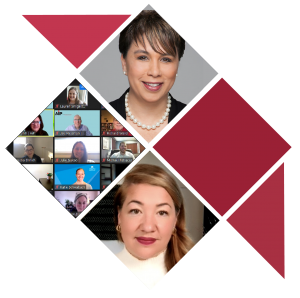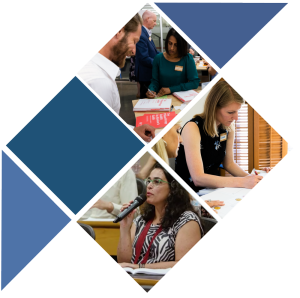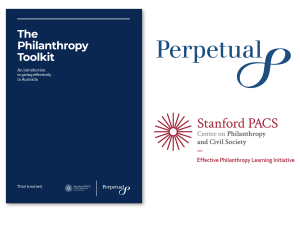Welcome to the Advisor’s Corner!
We have curated and developed the materials below to help advisors like you learn about effective philanthropy, and support your clients in elevating their philanthropic practice. You might use this information to refresh your memory about a workshop you attended with us, or maybe you want to share some of these materials in your presentations with your clients.
We love hearing your feedback on how to improve these resources, or ideas for what else might support you in your work.
Send suggestions to: contact-epli@stanford.edu
NOTE: All of our materials are under Creative Commons license, so we welcome you to use and adapt all EPLI materials found on our website, with the following attribution:
- If you wish to cite the Guide, please use the following attribution language:
This work is a derivative of “The Stanford PACS Guide to Effective Philanthropy” by Stanford Center on Philanthropy and Civil Society, copyright 2020 Board of Trustees of The Leland Stanford Junior University, used under Creative Commons Attribution 4.0 license. - If you wish to cite the Toolkit, please use the following attribution language:
This work is a derivative of “The Philanthropy Toolkit: an Introduction to Giving Effectively” by Stanford Center on Philanthropy and Civil Society, copyright 2020 Board of Trustees of The Leland Stanford Junior University, used under Creative Commons Attribution 4.0 license. - If citing both or some of our general resources, please use the following language: This work is a derivative of “The Stanford PACS Guide to Effective Philanthropy” or “The Philanthropy Toolkit: an Introduction to Giving Effectively” by Stanford Center on Philanthropy and Civil Society, copyright 2020 Board of Trustees of The Leland Stanford Junior University, used under Creative Commons Attribution 4.0 license.
Videos
For a complete list of our short videos on the core concepts of effective philanthropy and various Toolkit modules, check out our media library.
Handouts
FAQ’S For Advisors
-
How to use the Stanford Toolkit with Clients?
The Philanthropy Toolkit is composed of six modules, each module addresses different aspects of philanthropic planning process. We encourage you to make this toolkit work for your client’s unique needs. You do not have to go through the modules in order—feel free to use the toolkit modularly.Your client can work through each module with you during your meetings, or on their own and use your meetings to discuss completed modules. Additionally, you can cover multiple modules in one meeting, or focus on one module over several meetings. You can also involve family members in the process if your client so desire.
Once you have clarified your client’s interest in philanthropy, you can ask whether they are interested in having focused, structured conversations about giving in your meetings. When you present this toolkit to your clients, highlight how it can provide structure and tailored guidance for each step of the decision-making process, and that the toolkit also includes references for additional resources and networks that support an individual’s philanthropic learning and giving journey.
Before walking a client through the toolkit, we encourage you to go through each module yourself, applying the questions to your own philanthropic practice. In doing so, you will understand the content and the user experience more deeply. The Toolkit Primer (found here) will also help you navigate the toolkit in response to specific philanthropy-related questions.
Once you feel comfortable with the toolkit, identify a few clients who might be interested in incorporating philanthropic planning and this toolkit into their financial planning process. You may want to consider clients who have previously raised questions about their giving, or clients who have recently experienced a pivotal moment and for whom philanthropy may now be a higher priority—such as new empty nesters, recent retirees, or people managing greater wealth as the result of selling their business or receiving an inheritance.
-
How did we develop the Toolkit?
We created this toolkit in collaboration with hundreds of advisors across the United States in response to the philanthropic questions, challenges, and opportunities their clients face every day. High-capacity individuals are increasingly requesting guidance on their philanthropy, and often engage an ecosystem of advisors who are uniquely positioned to provide this support—including wealth advisors, tax and estate lawyers, etc. Clients want to navigate philanthropic planning with advisors who are already familiar with their circumstances.
Too often, the philanthropic conversation is overlooked or left to the last few minutes of a client-advisor meeting. Many advisors feel uncomfortable raising the subject of philanthropy because they don’t have a clear framework to use with their clients to walk them through the process. Advisors are trained to focus on tax optimization and ease of use in charitable planning, but this does not necessarily lead to the most values-based, effective approach for the clients. Despite these challenges, there are many benefits for advisors who are ready to engage in more meaningful, informed philanthropic discussions with their clients.
Advisors are well positioned to help clients balance the natural tension between the fear of running out of money and the desire to have an impact during their lifetime. In many cases, clients don’t realize how much they can give and end up looking back over lost opportunities.
As a trusted advisor, you can encourage your clients to reflect on their motivations and goals, prepare them to engage the nonprofit sector, and help them develop a robust, value-aligned giving strategy that fits their unique needs.
In an increasingly competitive landscape, the ability to provide philanthropic advice can help you:
- deepen your personal relationships with clients and their families
- differentiate your practice by offering philanthropic guidance that is in high demand and low supply, giving you a comparative advantage over advisors who are not providing this service
- retain current clients and their next generations
- expand your client base to include other high-capacity individuals who want to integrate philanthropy and wealth planning
- help your clients make the world a better place according to their values
- share in the pride of maximizing your clients’ philanthropic impact
Our research indicates that high-capacity donors find tailored, philanthropic conversations with their wealth advisors extremely helpful.
-
CONVERSATION STARTERS
When proactively starting the conversation, you may want to gauge your client’s interest in philanthropy with a few opening questions. These questions allow you to get to the deeper values and motivations behind your clients’ philanthropy.
If using these starting questions seems intimidating, consider role-playing the conversation with a colleague to prepare for a client meeting. Experiment with these questions until you have identified which questions, or how to revise these questions, so they feel natural to you.
1. Is philanthropy (charitable giving) important to you right now, or is it something you’d like to revisit in the future?
2. Tell me about your family’s values.
– What are some values that you and your family share?
– What values do you want to pass along to your family?
– How might these values inform your wealth planning process or your charitable giving?
– Is this something you would like to explore further in our meetings?
– Are you aware of any organizations that are working on these issues?
– Are you involved with any of these organizations?3. What issues are you (and your family) passionate about? Why? (Tell me more.)
– Have you given to any organization that you are excited about? If so, why?
– Is this something you would like to explore further in our meetings?4. Tell me about some important life experiences that have affected you.
– How might these experiences inform your wealth planning and/or your charitable giving?
– Is this something you would like to explore further in our meetings?5. What aspects of your identity are important to you?
– How does this affect how you view your wealth planning or your charitable giving?
– Is this something you would like to explore further in our meetings?6. Have you thought about what kind of legacy you want to leave?
– Is this something you would like to work on now, or something you’d like to revisit in the future? -
Questions for Donors to Ask Advisors
Here are some questions we recommend donors ask their advisors.
- Share your focus statement with your wealth advisor, and then ask them these 4 questions:
As I figure out how much to give, should I base my philanthropic budget on my assets, income, or other sources? - Can we review the Stanford Giving Vehicles comparison chart and discuss which ones best fit my philanthropic goals?
- Based on my impact goals and charitable tax-deduction goals, how much can I contribute to traditional 501c3 charities versus 501c4 advocacy groups or political entities? When and how should I think about charitable giving through estate planning, trusts, and bequests?
- Share your focus statement with your wealth advisor, and then ask them these 4 questions:
-
Can I hire Stanford to teach my group, company, or clients?
Thank you for your interest in introducing your group, company, or clients to effective philanthropy. There are a number of options for you to consider:
- We invite you and your colleagues to join us for the Effective Philanthropy for Advisors Workshops which we offer a number of times a year with our partners at Advisors In Philanthropy. Group discounts are available.
- To request a custom engagement, please:
– review our Education offerings, page or custom engagement brochure
– Fill out our Event Request Form
– Once we receive your event request form, we will contact you to discuss.
Please note that we generally deliver our educational programs to small, medium, and large audiences aligned with our mission, which focuses on high-capacity donors, donor support entities (community foundations, family offices, etc.), advisors (financial services, estate and trust planners, philanthropic advisors), philanthropic or social impact associations, companies with strong track records of employee philanthropic engagement, and conferences or events reaching such groups.
We look forward to hearing from you!



